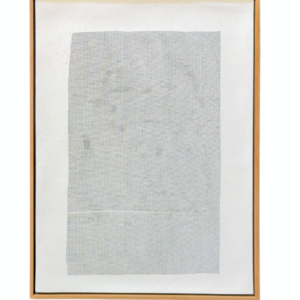WHATIFTHEWORLD, Cape Town
20.06 – 31.08.2019
All too often those who work behind the scenes in contemporary art dealerships – most of whom are highly intelligent young women – rarely get the credit they deserve for the work they do. On reading Lindsey Raymond’s promotional writings on the artists Chris Soal and Dan Halter’s joint-solo exhibition at WHATIFTHEWORLD, I was moved by the depth of insight her words demonstrated. While the artists are starkly different in their approach to both medium and content, what brings them together – and Raymond is right – is their commitment to a collective-yet-singular thinking and expression. If Halter’s works are centred, once again, on transience and displacement, and the stark and often tragic fate of migrants, Soal’s work, which carries none of this freightage, is also centred on the inextricability of the singular and plural. As the saying goes, we are whom we are because of others, whether this generates ill or good. Our fates are locked together, and the purpose of art, if it can be said to possess one, is that we must ensure that we carry each other in this increasingly inhumane time.
The title of Halter’s show – ‘Cross the River in a Crowd’ – forcefully reminds us that our survival, over and above the divisions that ensure that we remain separated by virtue of a so-called caste, race, gender, belief system, or economy, requires that we work together to overcome the many hatreds designed to keep us apart. The saying in full reads as follows – ‘Cross the river in a crowd and the crocodile won’t eat you’ – implying, as Raymond notes, that ‘only through grouping together and finding solidarity in the “whole” (rather than one identifiable target), can a people overcome injustices and hardships’. Yet still we criminalise the many and exempt the few; still we refuse the grace vital to the furtherance of a greater ‘whole’.
Halter’s exhibition, writes Raymond, is ‘a poetic and plaintive response to this period’ in which cruelty has become normative, suffering a banality. It is important to note, however, that Halter, after William Gass, is not making art for ‘lead-eared moralists and message gatherers’. The work is not reducible to the prevailing hatred and indignity which fuels xenophobic paranoia. Returning to his defining and idiomatic raw material – ‘China bags’ – Halter converts these into human and animal forms, reinforcing the interface of the synthetic and mortal, human-hewn and human-all-too-human. For it is our arrogance and our fragility that compels the artist, a compound which defines our Anthropocene Age in which we are rapidly losing the last vestiges of our humanity.
Caught between a cruelly harsh and an insidiously ‘soft’ diplomacy, ours is an age that normalises neglect and cruelty. It is in short a ‘neo-imperial’ age in which Africa remains on the fringe with begging bowl in hand, the continued victim of a rape as glaring as it is complex. There are words for this continued atrocity – zvakadhakwa, which ‘conveys the feeling of being stupefied with financial burdens’, or, Kuzvuva Dumbu, which refers to a gluttonous inequality. The oppressed are not blind to their unjust fate. What Halter seeks to do, however, is foreground this atrocity through works that speak in-and-through a poverty as material as it is psychic. I would have liked to have seen a crocodile made of ‘China bags’ slither down the sloping entrance to WHATIFTHEWORLD, its jaw agape, but what we do arrive upon on first entering the gallery is as unnerving, if not more so, for what we see is a creature that has been shunted to a shore, headless, its imploring dead hand caught in a rictus of hopelessness, its body weighted down with a plastic sack containing belongings it can no longer trade.

Chris Soal, Lament (We thought the good times would never end), 2019. Toothpicks in polyurethane sealant on industrial fabric, 170 x 230 x 60 cm
If Halter’s exhibition works like strychnine, as a poison which we cannot survive, then Soal’s exhibition achieves something starkly different. Titled ‘Field of Vision’, its terrain is not geopolitical. Yet it too asks us to think upon the waste which is inextricably associated with human survival and endeavour. Its core raw material is the ubiquitous toothpick we use to clear our foul mouths, first produced on an industrial scale by Marc Signorello in 1869. For Soal, however, the toothpick assumes a very different function, for when gathered and glued together in their tens of thousands they not only lose their initial function but assume a staggeringly innovative new one – as correlates, when grouped, for ‘skins, coats, and pelts’. It is the affective and not the use value that is important here, as it is in Halter’s retooled ‘China bags’, the wire frames for which are made by Kuda Kumba, the seam work by Sibongile Tete. But what makes Soal’s innovation so staggeringly beautiful and, dare I say it, so unutterably pure, is his transfiguration of a thing at once essential and disposable into something blindingly exquisite. This is because in seeing the work it does not follow that one knows it. The creative process is not cognitive or causal – it does not follow that this should mean that. This is because Soal trades in rarefaction, in art as an idealised lode, as an ‘ore in this earth’ – in this case birch – or, more gnomically, as ‘a rich source of something’.
It is this rich source which Soal has further enriched, for he has converted a vital-yet-banal birch toothpick into something immeasurably more profound. Soal notes that the ‘compulsion’ to use this particular material and tool grew from ‘the relationship between the singular and the plural’. While ‘the plural … made the work attractive … the singular … made it fascinating, engaging and important’. Here, once again, we find the abiding principle that links the works of Halter and Soal. Both artists value the individual and the collective, both understand that the collective can only possess its true value in-and-through the celebration of the individual. And it is this core realisation which gives their respective art its distinction, for neither Halter nor Soal is exercised by a prescriptive-if-all-too-real political condition and plight. Rather, both artists must find the means within themselves to connect with others, which, in their specific case, is irreducibly aesthetic.

Chris Soal, To see me as I am, 2019. Burnt and unburnt toothpicks in polyurethane sealant on industrial fabric, wooden frame, 117 x 91 x 13 cm
However, if Halter is unwaveringly focused on the geopolitical and the plight of a dispossessed and negated humanity in particular, then Soal, whose approach is more enigmatic, is focused on the continued importance of beauty in the midst of degradation. As Raymond elegantly phrases it, Soal’s works are ‘dripping, somatic bulges that protrude out of walls and spill onto floors … organic; they evoke comparisons to body cells and tree sap’. But I am also reminded of the work of another elemental artist, Jake Singer, who describes his sculptures as ‘murmurations’, a term associated with the movement of starlings, a majestically choreographed dance. This is because what compels Soal is the arc and flow of a movement. His works are not statements but adjectival insistences or evocations of the mystery that exists within discernible pattern. However, while his are secretive and deeply sensuous works, in their focus on the interface of the singular and plural, like Halter’s work they still speak truth to power.










